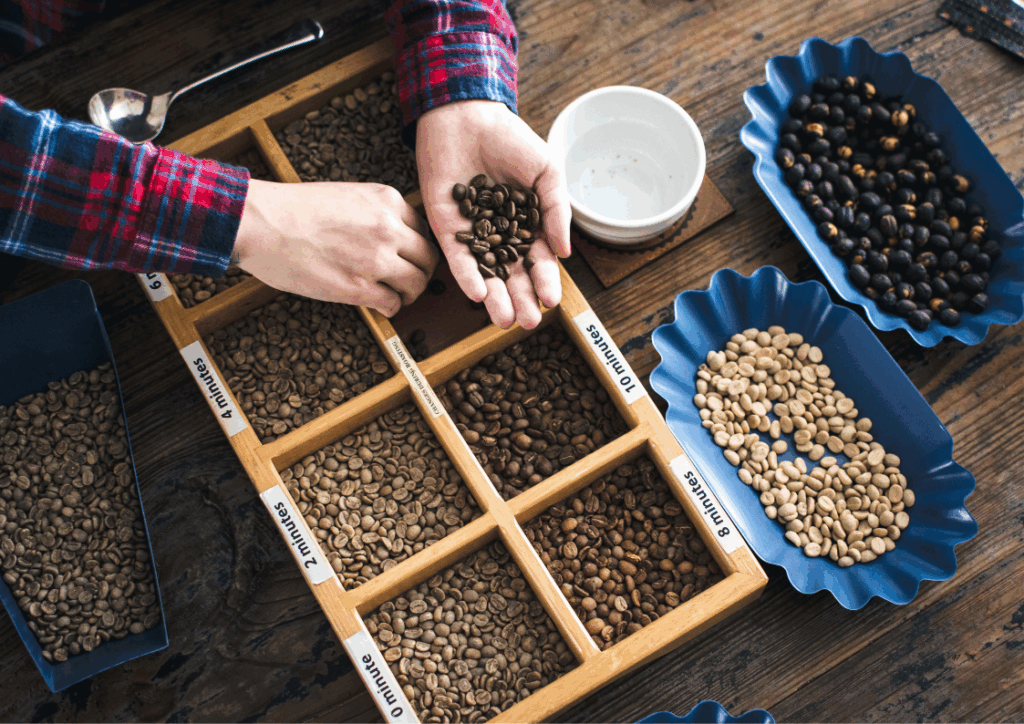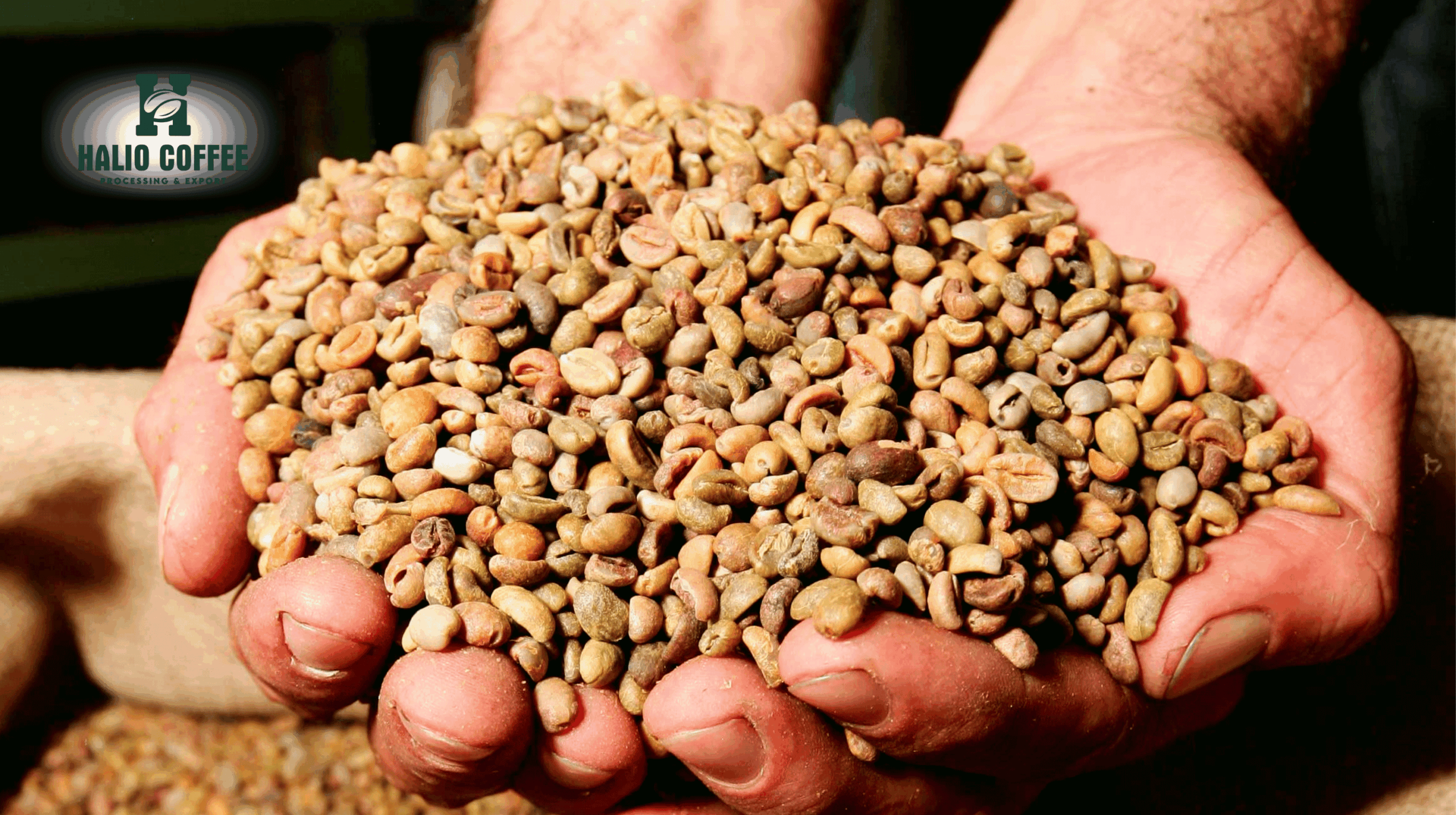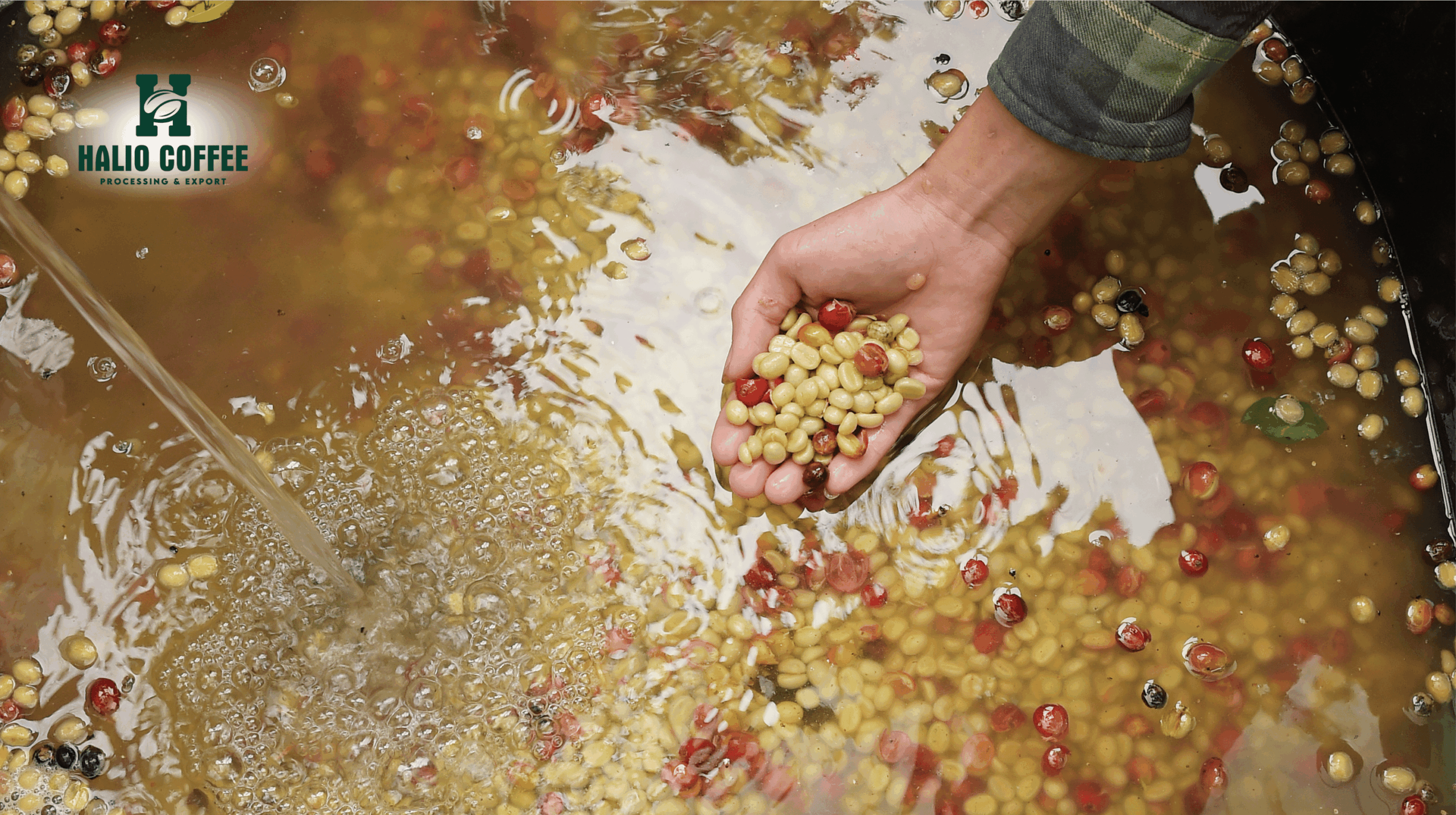Specialty Robusta Coffee Vietnam: A Technical Buyer’s Guide for Manufacturers, Distributors, and Roasters
Specialty Robusta coffee Vietnam has moved from commodity status to a credible, scalable option for espresso blends, RTD (ready-to-drink) products, capsules, and soluble applications. For companies sourcing at container volumes, Vietnam offers rare alignment of volume, price stability, and rising cup quality. This guide distills the agronomic realities, processing standards, pricing mechanics, quality specifications, logistics, and risk controls you need to evaluate supply—while linking to broader market context around Vietnam green coffee beans today and setting the stage for deeper sourcing models such as Direct trade Vietnamese Robusta coffee.
1) Vietnam’s Position in the Global Robusta Ecosystem
1.1 Output and Market Share
- Vietnam is the world’s #1 Robusta producer, supplying a large share of global Robusta exports in most recent seasons.
- Robusta accounts for ~90–95% of Vietnam’s coffee area; Arabica is concentrated in Lâm Đồng (Da Lat) and a few highland pockets.
- Production is clustered in the Central Highlands—Đắk Lắk, Gia Lai, Đắk Nông, and Kon Tum—on nutrient-rich basaltic soils ideal for high-yield Robusta.
1.2 Why Quality Is Rising
- Replanting programs replaced aging trees with high-yield, disease-resistant clones.
- Water-saving irrigation and soil management (mulching, shade integration) moderated past over-irrigation.
- Processing upgrades—from patio to raised-bed naturals, honey and controlled fermentations—brought Robusta into the specialty arena.
- Exporters have implemented moisture control, density sorting, optical sorting, and full traceability for top lots.
2) The Business Case for Specialty Robusta from Vietnam
2.1 What “Specialty Robusta” Means
In trade, specialty Robusta is not just “low defects.” It references lots that meet explicit physical and sensory benchmarks:
- Physical: low defect count, stable moisture 10.5–12.5%, water activity ≤0.60, screen size 16–18 for premium specs, high density after secondary cleaning/sorting.
- Sensory (R-grading): clean, sweet profile, minimal harshness; often 80+ on adapted Robusta cupping scales when processed well (natural/honey/washed).
- Traceability: farm, elevation, harvest date, process log, drying curves, and storage documentation.
2.2 Commercial Advantages for Manufacturing & Distribution
- Cost efficiency: Robustas typically price below Arabica at similar quality tiers; Vietnam’s scale can compress unit costs in instant, capsule, and blend formats.
- Functional advantages: Higher caffeine (≈2.2–2.7%), more crema, heavier body.
- Formulation flexibility: Enables lower-Arabica blend ratios while preserving intensity; ideal for chocolatey, nutty profiles in milk-based beverages.
- Supply security: Multiple provinces, many suppliers, better shipment regularity during peak seasons.
- Innovation pipeline: Fermented naturals and honey processes deliver fruit-forward profiles previously uncommon in Robusta.
3) Flavor Architecture of Vietnamese Specialty Robusta
3.1 Core Sensory Anchors
- Base: dark cocoa, roasted peanut, cedar, molasses, kola nut.
- Structure: low-medium acidity, high body, persistent crema.
- Sweetness: significantly improved via natural and honey drying; washed Robusta yields cleaner, drier cups for soluble/RTD.
3.2 Processing Pathways and Expected Profiles
- Sun-Dried / Natural: Dried cherry on patios or raised beds; flavors of dried fig, date, cacao nib, brown spice, with heavy body and long finish.
- Honey (Yellow/Red/Black): Mucilage retained during drying; caramelized sweetness, softer bitterness, medium body.
- Washed: Clean, crisp, reduced phenolics; better for instant extraction yield and filtration in RTD plants.
- Controlled Fermentations: Yeast-inoculated or anaerobic Robusta—notes of stewed fruit, rum raisin, baking spice; cup clarity depends on tight process controls.
4) Sourcing Framework: How to Evaluate Suppliers at Scale
4.1 Supplier Typologies
- Integrated exporters (farm → mill → export): Offer uniform QC and consolidated documentation; strong choice for long-term programs.
- Processing specialists: Buy cherry or parchment, then execute premium naturals/honey; ideal for specialty capsules and microlots.
- Co-ops & farmer groups: Traceable regional flavor and social impact; capacity varies—vet QC rigor and contractual reliability.
4.2 Due-Diligence Checklist
- Certifications: Organic, Rainforest Alliance, UTZ/4C, Fair Trade as required by your markets.
- Labor & environment: Written policies, pesticide lists, water use metrics, and smallholder support programs.
- Process controls: Fermentation logs, drying targets (target below 12% moisture), silo conditions, and water activity records.
- Lot integrity: Unique IDs, blend policies, cupping sheets, and periodic third-party verification.
- Logistics proficiency: FOB lead times, container booking performance, fumigation/phytosanitary readiness, and port options (Cát Lái, Quy Nhơn, Hải Phòng).
5) Specifications for Industrial Buyers
5.1 Standard Physical Specs (illustrative)
| Parameter | Specialty Robusta Target |
|---|---|
| Screen Size | 90% ≥ screen 16 (≥6.3 mm); premium lots 70% ≥ screen 18 |
| Moisture | 10.5–12.5% |
| Water Activity | ≤ 0.60 |
| Defects (SCA equivalent) | ≤ 5 full defects/350 g for top lots; ≤ 15 for premium bulk |
| Density | ≥ 700 g/L (pre-roast) |
| Color | 0–1% bleached/black beans (combined) |
| Odor | Clean, free from mold, smoke, taint |
| Quakers | ≤ 1% (post-roast inspection) |
5.2 Sensory Targets by Process
- Natural: clean, sweet, chocolate-forward; bitterness ≤ moderate; aftertaste clean, ≥ 80 on internal Robusta scale for top lots.
- Washed: neutral-clean, minimal woody notes, good sweetness.
- Honey/fermented: obvious fruit sweetness; no volatile acidity or phenolic spikes.
5.3 Packaging & Shelf Life
- Bags: 60 kg jute with grain-pro liners for specialty; container-bulk for soluble factories.
- Storage: < 25 °C, RH < 65%, stacked on pallets; rotate within 9–12 months post-milling for top flavor retention.
6) Price Formation and Hedging
6.1 Price Drivers for Vietnam Green Coffee Beans
- Global spreads: Robusta differentials vs. LIFFE futures (London).
- VND–USD exchange: FX shifts pass through to FOB quotes.
- Weather & flowering: Pre-flowering rains (Aug–Oct) and harvest dryness (Nov–Jan) move differentials.
- Policy & trade friction: Tariffs, freight surcharges, and phytosanitary regime changes affect landed costs.
6.2 Negotiation Pivots
- Differentials by grade & process (FAQ vs. Screen 18, washed vs. natural).
- Program volumes: Multi-container contracts can secure better diffs and priority milling.
- Flexible shipment windows: Avoiding peak port congestion (Dec–Jan) helps maintain schedules.
- Quality tolerance bands: Agree on measurable acceptance ranges (moisture, defects) and dispute resolution protocols.
6.3 Risk Tools
- Futures hedging (ICE Europe Robusta): Lock in basis + differential.
- Options overlays: Protect budgets during bloom risk or port congestion.
- Currency hedges: Forward cover for USD buyers with local currency cashflows.
7) From Farm to Factory: Processing Detail That Shapes the Cup
7.1 Harvest & Primary Sorting
- Selective strip picking is common; premium lots employ ripe-cherry selection.
- Floatation removes floaters; intact ripe fruit fed to naturals or pulpers (for washed/honey).
7.2 Fermentation & Drying Controls
Naturals
- Bed depth ≤ 4 cm on raised beds; frequent turning; initial shade for 48 hours to prevent case-hardening.
- Drying curve: Steady descent to 12% moisture over 12–18 days (weather-dependent).
- Risk: Mucilage molds; mitigated by airflow, thin layers, and covered beds during rain.
Washed
- De-pulp within 8–12 hours of harvest.
- Ferment in tiled or food-grade tanks; pH tracking and temperature < 25–28 °C.
- Wash to neutral, then patio/bed dry to 11–12%.
Honey
- Partial mucilage retention; strict hygiene to avoid phenolics; slower dry under shade nets.
7.3 Storage and Milling
- Conditioned silos with aeration; periodic water activity checks.
- Milling: pre-clean → hulling → size grading → density sorting → optical sorting → handpick for microlots.
- Pre-shipment: Independent inspection (SGS/CCIC) for quality/weight; cupping with buyer specs.
8) Roasting Playbooks for Specialty Robusta
8.1 Espresso & Milk-Forward Beverages
- Charge slightly higher than Arabica to drive momentum through first crack.
- Development time: 90–120 seconds post-first crack; stop before surface oiling to avoid harshness.
- Blend ratios: 20–50% Robusta with washed or natural Arabica to add crema and chocolate base.
8.2 Single-Origin Robusta Naturals
- Approach as you would a dense natural Arabica: lower end-temp, longer Maillard to build sweetness, keep bitterness in check.
- Target Agtron 55–60 for filter experiments; Agtron 50–55 for espresso.
8.3 Soluble and RTD Extraction
- Washed Robusta reduces oils and fines; higher brew yields at industrial scale; stable flavor in UHT treatments.
- For cold brew RTD, natural Robusta contributes cocoa depth and caffeine lift without sharp acidity.
9) Sustainability, Compliance, and Brand-Side Claims
9.1 Environmental Priorities
- Water stewardship: Drip irrigation and deficit irrigation to reduce aquifer pressure.
- Agroforestry: Shade trees (pepper, fruit, indigenous species) increase biodiversity and carbon sequestration.
- Soil health: Mulch, compost, reduced synthetic inputs; integrated pest management to limit residues.
9.2 Social Impact & Smallholder Economics
- Transparent price-sharing with farmers for specialty premiums.
- Long-term purchase programs tied to quality training, nursery support, and farm renovation.
- Health & safety in mills, equitable labor practices during harvest peaks.
9.3 Compliance & Certifications
- EU Deforestation Regulation (EUDR): geolocation data for plots, no-deforestation cutoff compliance.
- Maximum residue levels (MRLs): pesticide audits and input registries.
- Certifications (as needed): Organic, RFA, Fair Trade, 4C—align these with your brand story and buyer expectations.
10) Case Studies: How Companies Deploy Vietnamese Specialty Robusta
10.1 Capsule Brand (EU)
- Problem: rising Arabica differential squeezed margins on “Intenso” SKUs.
- Solution: 30–40% washed Vietnamese Robusta blended with Brazilian naturals; maintained crema and chocolate notes.
- Result: 12–15% COGS reduction, stable sensory acceptance in blind tests.
10.2 Third-Wave Roaster (US)
- Objective: showcase Specialty Robusta coffee Vietnam as a stand-alone seasonal.
- Action: single-origin natural from Đắk Lắk, selective pick + raised beds, 83-point cup.
- Outcome: sold as espresso and filter with educational content; attracted new audience seeking high-caffeine, chocolate-forward cups.
10.3 Soluble Producer (APAC)
- Shifted from mixed-origin Robusta to traceable washed Vietnamese Robusta with tighter MRL and moisture specs.
- Industrial brewhouse yields improved by 2–3%, fewer filter fouling incidents, and better flavor constancy.
11) Building a Program: From Samples to Contracted Supply
11.1 Sample Pathway
- Offer sample with lot ID, process, elevation, harvest date.
- QC test: moisture, water activity, screen analysis, roast curve, and 2-roast cupping.
- Pilot roast/production: espresso, filter, extraction yield tests (for soluble/RTD).
- Feedback loop with supplier; confirm acceptance specs and variance bands.
11.2 Contracting Mechanics
- Incoterms: FOB (Cát Lái/Quy Nhơn) common; CIF/DDP for turnkey solutions.
- Payment: LC at sight/30–60 days, or CAD with reputable forwarders.
- Quality clause: clear remedies—price adjustments, replacement, or credit for out-of-spec.
- Shipping windows: stagger bookings to manage port congestion and warehouse capacity.
11.3 Forecasting & Inventory
- Harvest calendar: cherry intake peaks Nov–Jan; best milling Dec–Mar; late-season lots risk moisture spikes—plan purchases accordingly.
- Safety stock: 1–2 months beyond transit to absorb delays; rotate based on first-milled, first-out (FMFO).
12) Quality Assurance: Lab Protocols for Receiving Teams
12.1 Physical Inspection
- Random sampling across bags; Grader’s 350 g method for defects.
- Sieve for screen distribution, measure density (g/L), moisture (capacitive meter), and water activity (Aqualab).
- Record odor, color, and insect/foreign matter incidence.
12.2 Cupping & Roast Controls
- Two roast levels (espresso, filter) with constant charge temps and gas profiles.
- Cupping 24 hours post-roast; log fragrance, flavor, aftertaste, body, acidity, balance, and clean cup.
- Keep a retained sample (green + roasted) for each lot delivered.
12.3 Stability Monitoring
- Monthly water activity checks in ambient warehouses.
- Cup retention samples at 30/60/90 days to track staling; adjust blend percentages if needed.
13) Product Development: Where Specialty Robusta Excels
13.1 Espresso & Milk Drinks
- Add 20–40% natural or honey Robusta to nut-and-cocoa-leaning blends; improves tactile weight and crema persistence.
- For high-milk beverages, Robusta’s low acidity prevents sourness while delivering chocolate depth.
13.2 Cold Brew & RTD
- Natural Robusta provides chocolate-malt sweetness without aggressive acidity; suitable for nitro and canned RTD profiles.
- Combine with a small Arabica fraction (10–20%) for aromatic lift.
13.3 Instant Coffee and 3-in-1 Mixes
- Washed Robusta supports consistent extraction yields and clean flavor baselines; compatible with flavor houses and dairy powders.
13.4 Functional & Energy Beverages
- Leverage higher caffeine with specialty flavor; position as “bold cocoa” or “Vietnam dark chocolate” profiles.
14) Compliance for EU, UK, and North America
14.1 EU (including EUDR)
- Require polygon geolocation for farm plots, proof of no deforestation post-cut-off, and due-diligence statements.
- Maintain chain-of-custody from plot → mill → exporter → importer.
14.2 UK & North America
- Emphasis on MRLs, allergen-free facilities, and FSMA-aligned documentation for U.S. buyers.
- Canada demands clear pesticide declarations and origin traceability.
14.3 Label Claims & Audits
- Substantiate claims such as “shade-grown,” “water-efficient,” “regenerative.”
- Align marketing copy with audited supplier data to prevent greenwashing exposure.
15) Practical Buying Scenarios & Model Specs
15.1 Espresso Blend Buyer (EU Distributor)
- Spec: Natural Robusta, Screen 18, Moisture 11.5%, ≤ 10 full defects/350 g, Wa ≤ 0.60.
- Use: 30% in a Brazil/Colombia base.
- Expected profile: dark chocolate, toasted almond, low acidity, heavy crema.
15.2 Soluble Plant (ASEAN)
- Spec: Washed Robusta, Screen 16 up, Moisture 11–12%, FM ≤ 0.1%, pesticide panel compliant.
- Use: Spray/Freeze-dry; target high extraction yield, clean taste.
15.3 Capsule Brand (D2C)
- Spec: Honey Robusta, Screen 18, hand-sorted, optical sorted twice.
- Use: 20% accent in “Intense” SKU; marketing story around Specialty Robusta coffee Vietnam and improved sustainability.
16) Logistics, Freight, and Costing Essentials
16.1 Ports and Routes
- Primary load ports: Cát Lái (HCMC) and Quy Nhơn; northern shipments via Hải Phòng.
- Common routings to EU: Transshipment via Singapore or Malaysia, 25–35 days depending on destination; to U.S. West Coast ~22–28 days.
16.2 Freight Considerations
- Peak season surcharges during late Q4–Q1; budget contingency.
- Fumigation requirements for specific markets; align with organic status where relevant (use approved methods).
16.3 Landed Cost Components
- FOB price + Ocean freight + Insurance + Destination port fees + Import duties/VAT.
- For EU duty relief on Vietnam via trade agreements, keep origin proof current.
17) Data Snapshots: Vietnam Green Coffee Beans in Trade
- Export volumes of Vietnam green coffee beans surge in years when global Robusta tightens.
- Average export unit values have climbed on improved quality and stronger demand in Europe and North America.
- The rise of specialty Robusta creates a premium band above commodity FAQ, especially for screen 18 naturals/honeys with traceability and certifications.
18) Common Pitfalls and How to Avoid Them
18.1 Overlooking Water Activity
Moisture alone is not enough. High Aw (>0.60) invites mold and flavor instability—mandate Aw testing in contracts.
18.2 Vague Quality Clauses
General terms like “good merchantable quality” cause disputes. Use numerical limits for defects, screen, moisture, Aw, and specify rejection/discount matrices.
18.3 Ignoring Late-Season Variability
Lots milled deep into the rainy tail can be soft and unstable. Favor early-to-mid-season milling for long voyages or extended warehousing.
18.4 Under-resourced QC on Arrival
Budget for arrival cupping, third-party labs when needed, and retention samples. Track supplier performance over time to build a preferred vendor list.
19) Building Brand Stories Around Specialty Robusta
19.1 Consumer Education Angles
- “Cocoa-rich intensity with naturally higher caffeine.”
- “Traceable lots from Đắk Lắk raised-bed naturals—Specialty Robusta coffee Vietnam.”
- “Water-smart farms and agroforestry in the Central Highlands.”
19.2 Trade Marketing for B2B Customers
- Provide lot-level spec sheets and cupping notes with each offer.
- Share shelf-life guidance and roast curves for predictable outcomes.
- Offer private-label and co-development for capsules/RTD/soluble.
20) Where the Market Is Heading Next
- Premiumization of Robusta: Controlled fermentation and honey processes will push more lots into 80+ scoring territory, blurring traditional Arabica/Robusta boundaries in blends.
- Compliance intensity: EUDR geolocation and deforestation checks make traceability-ready suppliers the default choice.
- Functional beverage crossover: RTD and energy categories will use Specialty Robusta for caffeine and cocoa depth with clean labels.
- Data-driven agriculture: IoT moisture probes, satellite rainfall tracking, and mobile farm logs will enable predictive quality contracting.
21) Sample Documents and Templates
21.1 Offer Sheet Template (extract)
- Origin/Province/District
- Variety/Clone (e.g., TR4, TR9 where relevant)
- Process (Natural/Honey/Washed; fermentation notes)
- Screen & Density
- Moisture & Water Activity
- Defects per 350 g (full/partial)
- Cupping Notes & Score
- Certifications & Geolocation readiness (for EUDR)
- FOB Port, Minimum Order, Availability Window, Incoterms
21.2 Arrival QC Form (extract)
- Container # / Seal #
- Sampling Protocol (bag count, pattern)
- Physical: Screen %, Density, Moisture, Aw, Defect Table
- Roast & Cupping Results (two profiles)
- Acceptance/Adjustment Decision, Photographic Evidence, Chain-of-Custody Log
22) Frequently Asked Technical Questions
Q1. Can specialty Robusta replace Arabica in our flagship espresso?
Often 20–40% substitution improves crema and texture without compromising flavor, provided the Robusta is washed or clean natural with low phenolics.
Q2. Are natural Robustas too risky for large-scale products?
Not if suppliers control drying curves, Aw, and storage. Use liners, specify Aw ≤ 0.60, and prioritize mid-harvest lots.
Q3. What about pesticide residues?
Work with suppliers maintaining MRL logs and pre-shipment lab tests. For EU, request full pesticide panels and align with the strictest customer requirement.
Q4. Does Vietnam offer consistent certified supply?
Yes—volumes of RFA/4C/Organic have grown; confirm farm groups and annual audit scope. Certified Vietnam green coffee beans are increasingly available at scale.
Q5. Which Incoterm is best?
FOB is most common; CIF helps new buyers. For stringent arrival timing, some partners offer DDP into specific markets via bonded logistics.
23) Bridging to the Next Topic: Relationship-Based Sourcing
This guide focused on technical purchasing foundations for Specialty Robusta coffee Vietnam and how it aligns with the broader market for Vietnam green coffee beans. The next logical step for teams aiming at deeper quality control and brand differentiation is to develop Direct trade Vietnamese Robusta coffee programs—structuring long-term farm contracts, quality premiums, and co-designed processing to secure repeatable flavor at scale.
- Halio Coffee – Trusted Vietnam Fresh Coffee Bean Supplier
- The Value Blueprint: Deconstructing the Premium Vietnam Green Coffee Price Europe
- A Consultant’s Guide to Vietnam Coffee Export Documentation
- Coffee Prices Today, September 17: Cooling Down After Strong Rally
- What Makes a “Specialty Coffee Sourcing Agent” Different?







